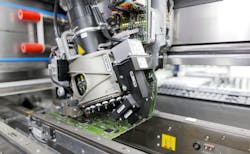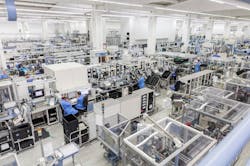How Siemens’ Amberg Factory Uses Red Hat OpenShift
Among the clearest pieces of evidence that the industrial digital transformation is underway is the increasing use of tools once reserved solely for IT in operations technology (OT) applications. In many cases, automation technology suppliers are showing the way by implementing these technologies in their own production operations.
A case in point is Siemens, whose Amberg electronics plant in Germany has moved away from a legacy Oracle system it used to run operational systems such as order management. This order management system at the Amberg facility manages 350 changeover processes between different production lines to ensure the right tools are in place and to update system status.
To replace the legacy system, Siemens is now using Red Hat OpenShift to create a more modular, microservices-based IT/OT architecture. This move allows developers at Siemens to apply artificial intelligence-generated data insights for smaller-scope changes to avoid disrupting operations.
Red Hat OpenShift is an enterprise Kubernetes container platform (see sidebar below for more information) deployed on premises in Siemens’ Amberg data center to create a cloud-native, modular architecture for its operational processes and systems.
According to Siemens, making changes to the previous Oracle system required planned system downtime due to the larger scope updates required by that system. Any unplanned downtime to the order management system on the Oracle system could impact the ability to meet the facility’s daily production goals for some 1,200 different products. Siemens Simatic products such as controllers, HMI, SCADA, and I/O are produced at the Amberg factory.
Amberg’s OpenShift application
With the improved data collection and analysis enabled by Red Hat OpenShift, Siemens’ developers can gain insights into current production system conditions and evaluate opportunities for ongoing improvement. Siemens is also using Red Hat OpenShift to automate routine tasks and support code reuse, enabling operations to continuously improve the performance of its production systems.
Integrated GitOps capabilities (which automate application development processes) in OpenShift enable more frequent updates and deployment of applications for uses such as predictive maintenance and quality assurance. These updates also continuously improve the prediction accuracy of OpenShift’s artificial intelligence tools used to analyze the Amberg’s factory data in the cloud.
Siemens is also using Red Hat OpenShift to address cybersecurity threats to its manufacturing systems. This is provided by Red Hat via ongoing patches and bug fixes for the entire container application stack.
“Security has become an increasing concern, given the value of our data, the complexity of our operations, and the potential cost of disruption,” said Schulze. “Even though our central IT team is only 80 km away in Munich, we cannot have any interruption in connectivity that would slow a production line in our manufacturing facility. Red Hat OpenShift allows us to complete patches on a rolling schedule with no disruption to daily production.”
What are Kubernetes containers?
As an open-source, extensible, and portable container management platform, Kubernetes is used for automating, configuring, and managing containerized workloads and services. Containers are bits of software which include the application code and its associated libraries and dependencies so that the software can be run anywhere—on a desktop, at the edge of the network, or in the cloud.
Kubernetes containers are like virtual machines (VMs) in that the containers have their own CPU share, filesystem, process space, and memory. A significant difference between Kubernetes containers and VMs is that Kubernetes containers are more lightweight because they can share an operating system among applications, they are decoupled from the underlying infrastructure, and they are portable across OS distributions and clouds.
Sources: avinetworks.com and ibm.com
About the Author
David Greenfield, editor in chief
Editor in Chief

Leaders relevant to this article:

